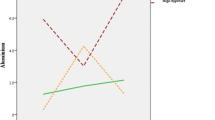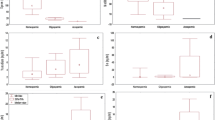Abstract
Chromium is an essential element that is required for the normal physiology but can be toxic to humans above a certain level. In spite of growing interest in research on chromium exposure to human health consensus about its effect on human, semen quality has not been achieved. The aim of the present study is to evaluate the impact of chromium exposure on semen parameters. A total of 760 males attending andrology laboratory of Tongji Hospital, Wuhan, for routine semen analysis were enrolled and requested to provide semen and urine samples. The urine level of chromium was evaluated using inductively coupled plasma mass spectrometry (ICP-MS), and computer-assisted semen analysis (CASA) was applied to examine semen parameters. Associations between semen parameters and urinary chromium were analyzed by means of multivariate linear regression analysis. Multivariate analysis showed a negative association between the urinary concentrations of chromium and progressive motility (β = − 0.014, p = 0.040) and total motility (β = − 1.077, p = 0.048), while other semen parameters did not show any statistically significant changes. Urinary chromium could influence semen quality parameters and impair male fecundity.

Similar content being viewed by others
Abbreviations
- Cr:
-
Chromium
- ICP-MS:
-
Inductively coupled plasma mass spectrometry
- CASA:
-
Computer-assisted semen analysis
- VCL:
-
Curvilinear velocity
- VSL:
-
Straight line velocity
- VAP:
-
Average path velocity
- ROS:
-
Reactive oxygen species
- LIN:
-
Linearity
- ALH:
-
Amplitude of lateral head displacement
- SRMs:
-
Standard reference materials
- LOQ:
-
Limits of quantification
- WHO:
-
World Health Organization
References
Acharya UR, Mishra M, Mishra I, Tripathy RR (2004) Potential role of vitamins in chromium induced spermatogenesis in Swiss mice. Environ Toxicol Pharmacol 15(2–3):53–59
Acharya UR, Mishra M, Tripathy RR, Mishra I (2006) Testicular dysfunction and antioxidative defense system of Swiss mice after chromic acid exposure. Reprod Toxicol 22(1):87–91
Agarwal A, Prabakaran SA (2005) Mechanism, measurement, and prevention of oxidative stress in male reproductive physiology. Indian J Exp Biol 43(11):963–974
Agarwal A, Ikemoto I, Loughlin KR (1994) Relationship of sperm parameters with levels of reactive oxygen species in semen specimens. J Urol 152(1):107–110
Ai CE, Li CJ, Tsou MC, Chen JL, Hsi HC, Chien LC (2019) Blood and seminal plasma mercury levels and predatory fish intake in relation to low semen quality. Environ Sci Pollut Res Int 26(19):19425–19433
Ammar O, Houas Z, Mehdi M (2019) The association between iron, calcium, and oxidative stress in seminal plasma and sperm quality. Environ Sci Pollut Res Int 26(14):14097–14105
Aruldhas MM, Subramanian S, Sekhar P, Vengatesh G, Govindarajulu P, Akbarsha MA (2006) In vivo spermatotoxic effect of chromium as reflected in the epididymal epithelial principal cells, basal cells, and intraepithelial macrophages of a nonhuman primate (macaca radiata geoffroy). Fertil Steril 86(4 Suppl):1097–1105
Asaduzzaman K, Khandaker MU, Binti Baharudin NA, Amin YBM, Farook MS, Bradley DA, Mahmoud O (2017) Heavy metals in human teeth dentine: a bio-indicator of metals exposure and environmental pollution. Chemosphere 176(2017):221–230
Bergamo P, Volpe MG, Lorenzetti S, Mantovani A, Notari T, Cocca E, Cerullo S, di Stasio M, Cerino P, Montano L (2016) Human semen as an early, sensitive biomarker of highly polluted living environment in healthy men: a pilot biomonitoring study on trace elements in blood and semen and their relationship with sperm quality and redox status. Reprod Toxicol 66(2016):1–9
Carette D, Perrard MH, Prisant N, Gilleron J, Pointis G, Segretain D, Durand P (2013) Hexavalent chromium at low concentration alters Sertoli cell barrier and connexin 43 gap junction but not claudin-11 and n-cadherin in the rat seminiferous tubule culture model. Toxicol Appl Pharmacol 268(1):27–36
Chandra AK, Chatterjee A, Ghosh R, Sarkar M, Chaube SK (2007) Chromium induced testicular impairment in relation to adrenocortical activities in adult albino rats. Reprod Toxicol 24(3–4):388–396
Crinnion WJ (2010) The cdc fourth national report on human exposure to environmental chemicals: what it tells us about our toxic burden and how it assist environmental medicine physicians. Altern Med Rev 15(2):101–109
Danadevi K, Rozati R, Reddy PP, Grover P (2003) Semen quality of Indian welders occupationally exposed to nickel and chromium. Reprod Toxicol 17(4):451–456
Das J, Kang MH, Kim E, Kwon DN, Choi YJ (2015) Kim JH (2015) hexavalent chromium induces apoptosis in male somatic and spermatogonial stem cells via redox imbalance. Sci Rep 5:13921
Davis RO, Rothmann SA, Overstreet JW (1992) Accuracy and precision of computer-aided sperm analysis in multicenter studies. Fertil Steril 57(3):648–653
Feng W, He X, Chen M, Deng S, Qiu G, Li X, Liu C, Li J, Deng Q, Huang S, Wang T, Dai X, Yang B, Yuan J, He M, Zhang X, Chen W, Kan H, Wu T (2015) Urinary metals and heart rate variability: a cross-sectional study of urban adults in Wuhan, China. Environ Health Perspect 123(3):217–222
Gil-Guzman E, Ollero M, Lopez MC, Sharma RK, Alvarez JG, Thomas AJ Jr, Agarwal A (2001) Differential production of reactive oxygen species by subsets of human spermatozoa at different stages of maturation. Hum Reprod 16(9):1922–1930
Guvvala PR, Sellappan S, Parameswaraiah RJ (2016) Impact of arsenic(v) on testicular oxidative stress and sperm functional attributes in Swiss albino mice. Environ Sci Pollut Res Int 23(18):18200–18210
Guzick DS, Overstreet JW, Factor-Litvak P, Brazil CK, Nakajima ST, Coutifaris C, Carson SA, Cisneros P, Steinkampf MP, Hill JA, Xu D, Vogel DL, National Cooperative Reproductive Medicine Network (2001) Sperm morphology, motility, and concentration in fertile and infertile men. N Engl J Med 345(19):1388–1393
Hepburn DD, Vincent JB (2003) Tissue and subcellular distribution of chromium picolinate with time after entering the bloodstream. J Inorg Biochem 94(1–2):86–93
Kleefstra N, Houweling ST, Bilo HJ (2007) Effect of chromium supplementation on glucose metabolism and lipids: a systematic review of randomized controlled trials. Diabetes Care 30(9):e102 author reply e103
Kumar S, Sathwara NG, Gautam AK, Agarwal K, Shah B, Kulkarni PK, Patel K, Patel A, Dave LM, Parikh DJ, Saiyed HN (2005) Semen quality of industrial workers occupationally exposed to chromium. J Occup Health 47:424–430
Kumar KM, Aruldhas MM, Banu SL, Sadasivam B, Vengatesh G, Ganesh KM, Navaneethabalakrishnan S, Navin AK, Michael FM, Venkatachalam S, Stanley JA, Ramachandran I, Banu SK, Akbarsha MA (2017) Male reproductive toxicity of CRVI: in-utero exposure to crvi at the critical window of testis differentiation represses the expression of Sertoli cell tight junction proteins and hormone receptors in adult f1 progeny rats. Reprod Toxicol 69(2017):84–98
Li H, Chen Q, Li S, Xu Y, Yao W, Chen C (1999) Studies on male reproductive toxicity caused by hexavalent chromium. Zhonghua Yu Fang Yi Xue Za Zhi 33(6):351–353
Li H, Chen Q, Li S, Yao W, Li L, Shi X, Wang L, Castranova V, Vallyathan V, Ernst E, Chen C (2001) Effect of Cr(VI) exposure on sperm quality: human and animal studies. Ann Occup Hyg 45(7):505–511
Li Y, Gao Q, Li M, Li M, Gao X (2014) Cadmium, chromium, and copper concentration plus semen-quality in environmental pollution site, China. Iran J Public Health 43(1):35–41
Machac N, Kaya Karasu G, Sahin N, Orhan C, Sahin K, Iben C (2019) Effects of supplementation of chromium histidinate on glucose, lipid metabolism and oxidative stress in cats. J Anim Physiol Anim Nutr 103(1):331–338
Marouani N, Tebourbi O, Mahjoub S, Yacoubi MT, Sakly M, Benkhalifa M, Rhouma KB (2012) Effects of hexavalent chromium on reproductive functions of male adult rats. Reprod Biol 12(2):119–133
Marzec-Wroblewska U, Kaminski P, Lakota P, Szymanski M, Wasilow K, Ludwikowski G et al (2019) Human sperm characteristics with regard to cobalt, chromium, and lead in semen and activity of catalase in seminal plasma. Biol Trace Elem Res 188(2):251–260
Pant N, Kumar G, Upadhyay AD, Patel DK, Gupta YK, Chaturvedi PK (2014) Reproductive toxicity of lead, cadmium, and phthalate exposure in men. Environ Sci Pollut Res Int 21(18):11066–11074
Petersen R, Thomsen JF, Jorgensen NK, Mikkelsen S (2000) Half life of chromium in serum and urine in a former plasma cutter of stainless steel. Occup Environ Med 57(2):140–142
Pokhrel G, Yihao S, Wangcheng W, Khatiwada SU, Zhongyang S, Jianqiao Y et al (2019) The impact of sociodemographic characteristics, lifestyle, work exposure and medical history on semen parameters in young Chinese men: a cross-sectional study. Andrologia 51(8):e13324
Ramya T, Misro MM, Sinha D, Nandan D (2010) Sperm function and seminal oxidative stress as tools to identify sperm pathologies in infertile men. Fertil Steril 93(1):297–300
Samplaski MK, Agarwal A, Sharma R, Sabanegh E (2010) New generation of diagnostic tests for infertility: review of specialized semen tests. Int J Urol 17(10):839–847
Shiva M, Gautam AK, Verma Y, Shivgotra V, Doshi H, Kumar S (2011) Association between sperm quality, oxidative stress, and seminal antioxidant activity. Clin Biochem 44(4):319–324
Srigboh RK, Basu N, Stephens J, Asampong E, Perkins M, Neitzel RL, Fobil J (2016) Multiple elemental exposures amongst workers at the Agbogbloshie electronic waste (e-waste) site in Ghana. Chemosphere 164(2016):68–74
Suksomboon N, Poolsup N, Yuwanakorn A (2014) Systematic review and meta-analysis of the efficacy and safety of chromium supplementation in diabetes. J Clin Pharm Ther 39(3):292–306
Tomlinson MJ, Naeem A (2018) Computer-aided sperm analysis (casa) in the medical laboratory: casa in diagnostic andrology and assisted conception. Reprod Fertil Dev 30(6):850
Tuttelmann F, Ruckert C, Ropke A (2018) Disorders of spermatogenesis: perspectives for novel genetic diagnostics after 20 years of unchanged routine. Med Genet 30(1):12–20
von Burg R, Liu D (1993) Chromium and hexavalent chromium. J Appl Toxicol 13(3):225–230
Wan ZZ, Chen HG, Lu WQ, Wang YX, Pan A (2019) Metal/metalloid levels in urine and seminal plasma in relation to computer-aided sperm analysis motion parameters. Chemosphere 214(2019):791–800
WHO (2010) WHO laboratory manual for the examination and processing of human semen. fifth ed. Available at: http://apps.who.int/iris/bitstream/10665/44261/1/9789241547789_eng.pdf
Xu DX, Shen HM, Zhu QX, Chua L, Wang QN, Chia SE, Ong CN (2003) The associations among semen quality, oxidative DNA damage in human spermatozoa and concentrations of cadmium, lead and selenium in seminal plasma. Mutat Res 534(1–2):155–163
Zeng Q, Feng W, Zhou B, Wang YX, He XS, Yang P, You L, Yue J, Li YF, Lu WQ (2015) Urinary metal concentrations in relation to semen quality: a cross-sectional study in China. Environ Sci Technol 49(8):5052–5059
Zhen L, Wang L, Fu J, Li Y, Zhao N, Li X (2016) Hexavalent chromium affects sperm motility by influencing protein tyrosine phosphorylation in the midpiece of boar spermatozoa. Reprod Toxicol 59:66–79
Zheng W, Ge F, Wu K, Chen X, Li X, Chen Y et al (2018) In utero exposure to hexavalent chromium disrupts rat fetal testis development. Toxicol Lett 15(299):201–209
Zhou Y, Fu XM, He DL, Zou XM, Wu CQ, Guo WZ, Feng W (2016) Evaluation of urinary metal concentrations and sperm DNA damage in infertile men from an infertility clinic. Environ Toxicol Pharmacol 45(2016):68–73
Acknowledgments
We sincerely thank all the participants of this study for providing the semen and urine samples. We also thank the technicians in the andrology laboratory of Tongji Hospital for analyzing the semen quality parameters.
Author information
Authors and Affiliations
Corresponding authors
Additional information
Responsible editor: Philippe Garrigues
Publisher’s note
Springer Nature remains neutral with regard to jurisdictional claims in published maps and institutional affiliations.
Rights and permissions
About this article
Cite this article
Pokhrel, G., Shi, Y., Wang, W. et al. Correlation between urinary chromium level and semen quality in men attending an andrology laboratory. Environ Sci Pollut Res 27, 23301–23308 (2020). https://doi.org/10.1007/s11356-020-08890-2
Received:
Accepted:
Published:
Issue Date:
DOI: https://doi.org/10.1007/s11356-020-08890-2




